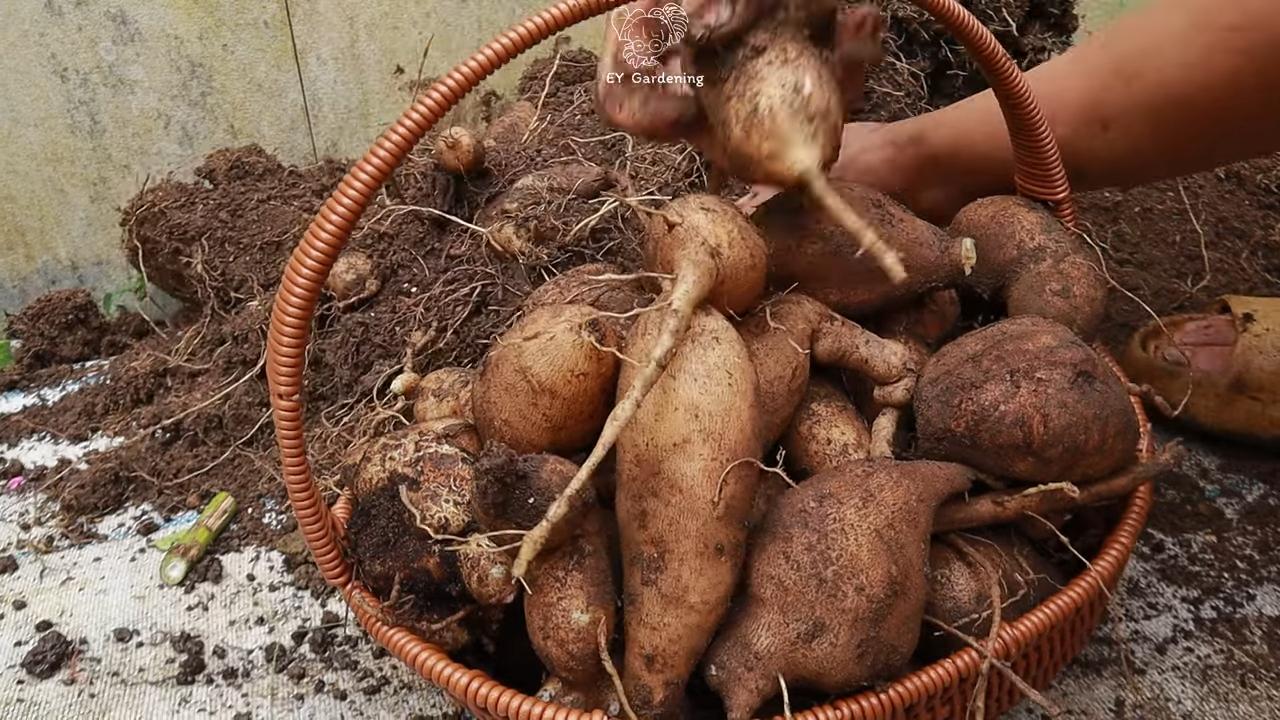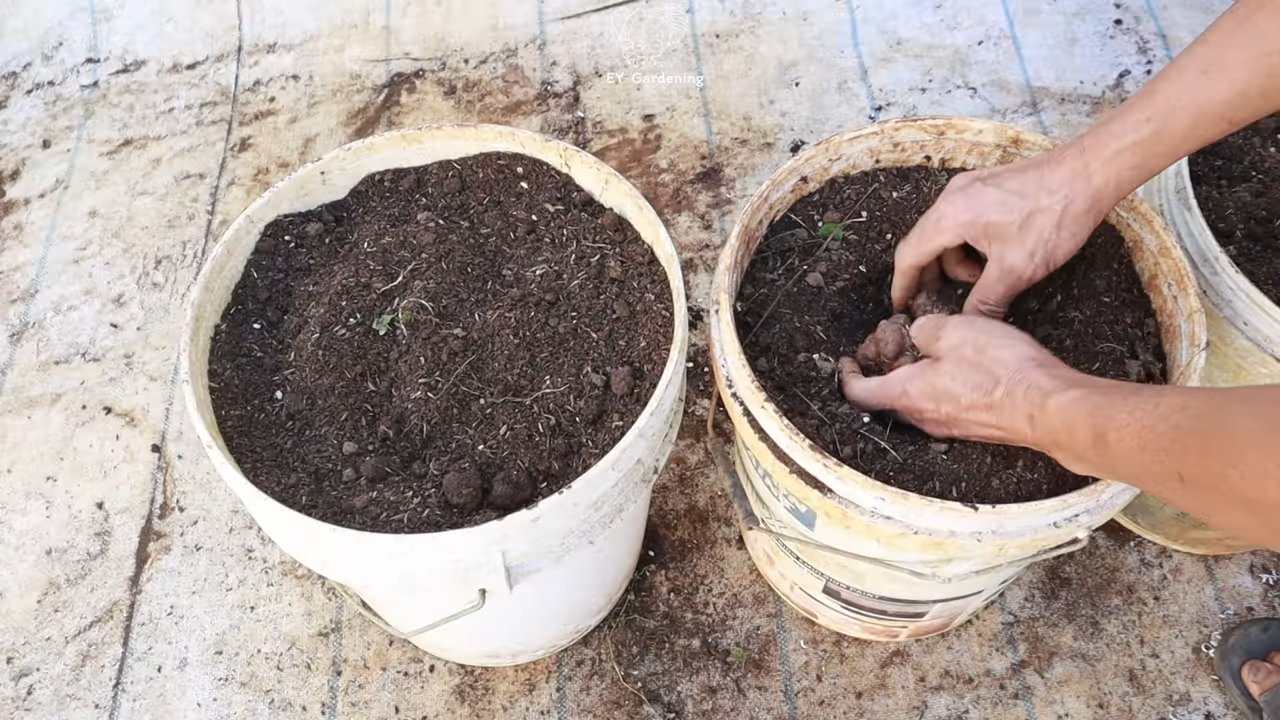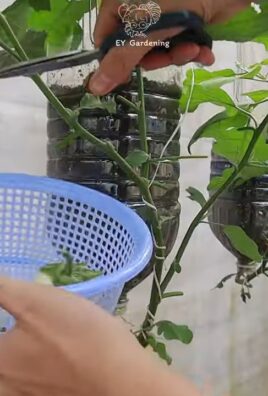Growing Yacon at Home might sound like an exotic adventure, and trust me, it kind of is! Have you ever dreamt of harvesting sweet, juicy tubers right from your own backyard? Well, with a little know-how, you absolutely can! This isn’t just about gardening; it’s about connecting with a food source that has a rich history and incredible health benefits.
Yacon, also known as the Peruvian ground apple, has been cultivated in the Andes for centuries. Imagine the ancient Incas enjoying this naturally sweet treat! Now, you can bring that same tradition to your own garden. But why should you bother? In today’s world, we’re all looking for healthier, more sustainable food options. Yacon is naturally low in calories and packed with prebiotics, making it a fantastic addition to any diet. Plus, there’s nothing quite like the satisfaction of growing your own food.
This DIY guide will walk you through everything you need to know about successfully growing Yacon at Home. From choosing the right location to harvesting your delicious tubers, I’ll share my best tips and tricks to ensure a bountiful harvest. Get ready to get your hands dirty and enjoy the sweet rewards of your labor!

Growing Yacon at Home: A Beginner’s Guide
Yacon, also known as the Peruvian ground apple, is a fantastic root vegetable that’s gaining popularity for its sweet, slightly pear-like flavor and health benefits. I’ve been growing yacon in my backyard for a few years now, and I’m excited to share my experience and guide you through the process. It’s surprisingly easy, even if you’re a beginner gardener!
What You’ll Need
Before we dive in, let’s gather the essentials. You’ll need:
* Yacon Crowns or Rhizomes: This is the most crucial part! You can usually find these online or at specialty nurseries. Make sure they look healthy and have visible buds (eyes).
* Well-Draining Soil: Yacon doesn’t like soggy feet. A mix of garden soil, compost, and perlite works wonders.
* Large Pots or Garden Bed: Yacon plants get quite large, so give them plenty of room.
* Compost or Aged Manure: For enriching the soil and providing nutrients.
* Watering Can or Hose: For regular watering.
* Gardening Gloves: To keep your hands clean and protected.
* Shovel or Trowel: For planting.
* Mulch (optional): To help retain moisture and suppress weeds.
* Stakes or Trellis (optional): To support the tall plants, especially in windy areas.
Choosing the Right Location
Yacon thrives in sunny locations. Aim for at least 6-8 hours of direct sunlight per day. While they can tolerate some partial shade, you’ll get the best yields with plenty of sunshine. Also, consider the space you have available. Yacon plants can grow to be 6-7 feet tall and wide, so make sure you have enough room for them to spread out. If you’re growing in pots, choose large containers (at least 20 gallons) to accommodate their root system.
Planting Yacon: Step-by-Step
Now for the fun part – planting! Here’s how I do it:
1. Prepare the Soil: Whether you’re using pots or a garden bed, start by preparing the soil. Dig a hole that’s about twice as wide and as deep as the yacon crown or rhizome. Mix in plenty of compost or aged manure to enrich the soil. This will provide the plants with the nutrients they need to grow strong and healthy.
2. Planting the Crowns/Rhizomes: Place the yacon crown or rhizome in the hole with the buds (eyes) facing upwards. Cover it with soil, leaving about an inch or two of soil above the top of the crown. Gently pat down the soil to remove any air pockets.
3. Water Thoroughly: After planting, water the area thoroughly. This will help settle the soil and encourage the roots to start growing.
4. Mulch (Optional): Apply a layer of mulch around the base of the plant. This will help retain moisture, suppress weeds, and regulate soil temperature. I like to use straw or wood chips.
5. Spacing: If you’re planting multiple yacon plants, space them about 3-4 feet apart to give them enough room to grow.
Caring for Your Yacon Plants
Once your yacon plants are in the ground, it’s important to provide them with the care they need to thrive.
1. Watering: Yacon plants need consistent moisture, especially during hot, dry weather. Water deeply whenever the top inch of soil feels dry to the touch. Avoid overwatering, as this can lead to root rot.
2. Fertilizing: Yacon plants are heavy feeders, so they benefit from regular fertilization. I like to use a balanced organic fertilizer every few weeks during the growing season. You can also side-dress with compost or aged manure.
3. Weeding: Keep the area around your yacon plants free of weeds. Weeds compete with the plants for nutrients and water, so it’s important to remove them regularly.
4. Staking or Trellising (Optional): As yacon plants grow tall, they may need support, especially in windy areas. You can use stakes or a trellis to help keep them upright.
5. Pest and Disease Control: Yacon plants are generally resistant to pests and diseases. However, they can sometimes be affected by slugs, snails, or aphids. If you notice any pests, you can control them with organic pest control methods, such as hand-picking, insecticidal soap, or neem oil.
Harvesting Yacon: The Sweet Reward
The best part about growing yacon is, of course, the harvest! Here’s how to know when and how to harvest your yacon tubers:
1. Timing: Yacon tubers are typically ready to harvest in the late fall or early winter, after the first frost. The frost will kill the above-ground foliage, signaling that it’s time to harvest. In warmer climates, you can harvest before the first frost, but the tubers may not be as sweet.
2. Digging Up the Tubers: Carefully dig around the base of the plant, being careful not to damage the tubers. Use a shovel or garden fork to gently lift the plant out of the ground.
3. Separating the Tubers: Once you’ve dug up the plant, you’ll notice two types of roots: the small, reddish rhizomes (which you’ll use to propagate new plants) and the large, brown tubers (which are the edible part). Separate the tubers from the rhizomes.
4. Curing the Tubers: After harvesting, yacon tubers need to be cured for a few days to a few weeks to develop their sweetness. To cure them, simply leave them in a cool, dry place, out of direct sunlight. The tubers will become sweeter and more flavorful as they cure. I usually cure mine in my garage for about a week.
5. Storing the Tubers: Once the tubers are cured, you can store them in a cool, dry place for several months. I like to store mine in a cardboard box in my basement.
Propagating Yacon
One of the great things about yacon is that it’s easy to propagate. You can use the rhizomes (the small, reddish roots) to grow new plants.
1. Dividing the Rhizomes: In the spring, before planting, carefully divide the rhizomes into sections, making sure each section has at least one bud (eye).
2. Planting the Rhizomes: Plant the rhizomes in pots or directly in the garden, following the same planting instructions as for the crowns.
3. Caring for the New Plants: Water and fertilize the new plants regularly, and they should start growing quickly.
Enjoying Your Yacon Harvest
Now that you’ve harvested your yacon tubers, it’s time to enjoy them! Yacon tubers can be eaten raw or cooked. They have a sweet, slightly pear-like flavor and a crisp, juicy texture.
* Raw: You can peel and slice yacon tubers and eat them raw as a snack or add them to salads.
* Cooked: Yacon tubers can be roasted, baked, grilled, or stir-fried. They can also be used in soups and stews.
* Juice: Yacon juice is a refreshing and healthy beverage.
* Syrup: Yacon syrup is a natural sweetener that’s lower in calories than sugar.
Troubleshooting
Even with the best care, you might encounter some challenges when growing yacon. Here are a few common problems and how to address them:
* Slow Growth: If your yacon plants are growing slowly, it could be due to a lack of sunlight, nutrients, or water. Make sure they’re getting enough sunlight, fertilize them regularly, and water them deeply whenever the soil feels dry.
* Yellowing Leaves: Yellowing leaves can be a sign of nutrient deficiency or overwatering. Check the soil moisture and adjust your watering accordingly. Fertilize the plants with a balanced fertilizer.
* Pests: Slugs, snails, and aphids can sometimes attack yacon plants. Control them with organic pest control methods.
* Root Rot: Root rot is caused by overwatering. Make sure your soil is well-draining and avoid overwatering.
Yacon Varieties
While there aren’t a ton of distinct varieties readily available to home gardeners, you might encounter some slight variations in tuber size, shape, and sweetness. Most nurseries simply sell “Yacon” without specifying a particular variety. However, if you’re lucky, you might find some named varieties like ‘Morado’ (known for its purple-tinged tubers) or varieties selected for specific growing conditions. Don’t worry too much about the specific variety; the general growing principles remain the same.
Why Grow Yacon?
Beyond the delicious taste, there are several compelling reasons to grow y

Conclusion
So, there you have it! Growing yacon at home is not only achievable, but it’s a rewarding experience that brings a unique and delicious crop right to your table. We’ve walked through the steps, from selecting the right variety and preparing your soil to harvesting those sweet, crisp tubers. The beauty of this DIY project lies in its simplicity and the satisfaction of nurturing something from the ground up.
Why is this a must-try? Because yacon offers a delightful alternative to traditional sweeteners, boasting a naturally sweet flavor with a low glycemic index. This makes it a fantastic option for those watching their sugar intake or simply seeking a healthier way to enjoy sweetness. Beyond its health benefits, yacon is incredibly versatile in the kitchen. You can enjoy it raw, adding a refreshing crunch to salads or slaws. You can juice it for a naturally sweet beverage. You can even bake with it, incorporating it into pies, muffins, and other desserts.
Don’t be afraid to experiment! Consider these variations to personalize your yacon-growing journey:
* Vertical Gardening: If you’re short on space, try growing yacon in large containers or grow bags. This allows you to maximize your yield even in limited areas.
* Companion Planting: Enhance your yacon patch by planting companion plants like marigolds or basil. These can help deter pests and attract beneficial insects, creating a healthier growing environment.
* Different Varieties: Explore different yacon varieties to discover your favorite flavor profile. Some varieties are sweeter than others, while some have a more pronounced earthy taste.
* Yacon Syrup: Once you’ve harvested your yacon, consider making your own yacon syrup. This concentrated sweetener is a delicious and healthy alternative to refined sugar.
Growing yacon at home is more than just a gardening project; it’s an investment in your health and well-being. It’s a chance to connect with nature, learn new skills, and enjoy the fruits (or rather, tubers) of your labor. The process is relatively straightforward, and the rewards are well worth the effort.
We encourage you to take the plunge and embark on your own yacon-growing adventure. Share your experiences with us! We’d love to hear about your successes, challenges, and creative ways you’re using your homegrown yacon. Post pictures of your yacon plants, share your favorite recipes, and let us know what you’ve learned along the way. Together, we can build a community of yacon enthusiasts and spread the word about this amazing plant. So, get your hands dirty, nurture your yacon plants, and enjoy the sweet rewards of your hard work. Happy growing!
Frequently Asked Questions (FAQ)
What exactly is yacon, and why should I grow it?
Yacon (Smallanthus sonchifolius) is a perennial plant native to the Andes region of South America. It’s grown for its crisp, sweet-tasting tubers, which are similar in texture to an apple or pear. The tubers are rich in fructooligosaccharides (FOS), a type of prebiotic fiber that promotes gut health and has a low glycemic index, making it a healthier alternative to sugar. Growing yacon at home allows you to have a fresh, readily available source of this nutritious and delicious food. Plus, it’s a fun and rewarding gardening experience!
How much space do I need to grow yacon?
Yacon plants can grow quite large, reaching up to 6 feet tall and wide. Ideally, you should allocate at least 3-4 feet of space between plants. If you’re growing in containers, choose large pots (at least 20 gallons) to accommodate the plant’s root system. If space is limited, consider vertical gardening techniques or dwarf varieties.
What kind of soil does yacon need?
Yacon thrives in well-drained, fertile soil that is rich in organic matter. Before planting, amend your soil with compost, aged manure, or other organic materials to improve its drainage and nutrient content. A slightly acidic to neutral soil pH (around 6.0 to 7.0) is ideal. Avoid heavy clay soils, as they can retain too much moisture and lead to root rot.
How often should I water my yacon plants?
Yacon plants need consistent moisture, especially during hot, dry weather. Water deeply whenever the top inch of soil feels dry to the touch. Avoid overwatering, as this can also lead to root rot. During the growing season, you may need to water your plants several times a week, depending on the weather conditions. Mulching around the base of the plants can help retain moisture and suppress weeds.
When is the best time to plant yacon?
The best time to plant yacon is in the spring, after the last frost. You can start yacon plants indoors from crowns (the top portion of the tuber with buds) a few weeks before the last frost to get a head start on the growing season. Alternatively, you can purchase yacon plants from a nursery or garden center.
How long does it take for yacon to mature?
Yacon typically takes 6-7 months to mature. You can harvest the tubers in the fall, after the foliage has died back. The longer you leave the tubers in the ground, the sweeter they will become.
How do I harvest yacon?
To harvest yacon, carefully dig around the base of the plant with a garden fork or shovel. Gently lift the plant out of the ground, being careful not to damage the tubers. Separate the tubers from the crown (the top portion of the tuber with buds). The tubers can be eaten raw or cooked, while the crown can be replanted to grow new plants.
How do I store yacon tubers?
Yacon tubers can be stored in a cool, dark, and dry place for several months. Avoid storing them in the refrigerator, as this can cause them to become bitter. You can also store them in a root cellar or bury them in sand or sawdust.
Are there any pests or diseases that affect yacon?
Yacon is generally resistant to pests and diseases. However, it can be susceptible to slugs, snails, and aphids. You can control these pests with organic methods, such as hand-picking, beer traps, or insecticidal soap. Root rot can also be a problem if the soil is poorly drained.
Can I grow yacon in containers?
Yes, you can grow yacon in containers. Choose large pots (at least 20 gallons) with drainage holes. Use a well-draining potting mix and water regularly. Container-grown yacon plants may need to be fertilized more frequently than those grown in the ground.
Is yacon safe for everyone to eat?
Yacon is generally safe for most people to eat. However, some people may experience digestive discomfort, such as gas or bloating, if they consume large amounts of yacon. Start with small portions and gradually increase your intake to see how your body reacts. People with fructose malabsorption may also need to limit their yacon consumption. As always, consult with your doctor or a registered dietitian if you have any concerns.
Can I make yacon syrup at home?
Yes, you can make yacon syrup at home. To do so, juice the yacon tubers and then simmer the juice over low heat until it thickens into a syrup. Be careful not to burn the syrup. The syrup can be used as a natural sweetener in beverages, desserts, and other recipes.
What are some other ways to use yacon?
Besides eating it raw or making syrup, yacon can be used in a variety of other ways. You can add it to salads, slaws, and stir-fries. You can bake it into pies, muffins, and other desserts. You can also juice it or blend it into smoothies. The leaves of the yacon plant can also be used to make tea.
Where can I find yacon crowns or plants?
You can find yacon crowns or plants at some nurseries and garden centers, especially those that specialize in unusual or heirloom plants. You can also purchase them online from reputable seed companies or specialty growers. Make sure to choose a reputable source to ensure that you are getting healthy, disease-free plants.




Leave a Comment